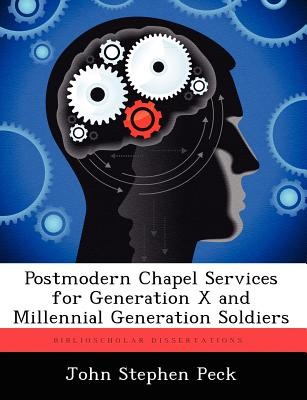
- We will send in 10–14 business days.
- Author: John Stephen Peck
- Publisher: BiblioScholar
- ISBN-10: 1249284597
- ISBN-13: 9781249284598
- Format: 18.9 x 24.6 x 0.8 cm, softcover
- Language: English
- SAVE -10% with code: EXTRA
Postmodern Chapel Services for Generation X and Millennial Generation Soldiers (e-book) (used book) | bookbook.eu
Reviews
Description
The intent of this thesis is to examine the spiritual needs of the majority of soldiers by age demographic. They are from two postmodern generations, Generation X and the Millennial Generation. The thesis examines generational differences, the decline of Christendom, and the rise of postmodernism. The thesis examines American church models, particularly those that attract the highest percentage of postmoderns. The author identifies and analyzes the key principles of these models and compares them to the common forms of chapel services. The Army currently conducts Protestant chapel services at all its installations. Aside from denomination or ethnic specific services, these services primarily fall into three models, 45% are traditional, 40% are a blended service typically called "contemporary" and 15% are a pragmatic (seeker or purpose driven) model. However, in civilian ministry none of these models consistently attract postmodern generations. The Emerging Church model which does attract postmoderns is not used in the Army. This author identifies twelve consistent characteristics of emerging churches that connect with postmodern generations. These transcend whether the church is theologically conservative or liberal. The author makes ten recommendations to address the problem of chapels unintentionally aiming at the wrong generational target. These approaches will bring garrison chapel services into this millennium and on target with the majority of the Army.
EXTRA 10 % discount with code: EXTRA
The promotion ends in 18d.22:48:31
The discount code is valid when purchasing from 10 €. Discounts do not stack.
- Author: John Stephen Peck
- Publisher: BiblioScholar
- ISBN-10: 1249284597
- ISBN-13: 9781249284598
- Format: 18.9 x 24.6 x 0.8 cm, softcover
- Language: English English
The intent of this thesis is to examine the spiritual needs of the majority of soldiers by age demographic. They are from two postmodern generations, Generation X and the Millennial Generation. The thesis examines generational differences, the decline of Christendom, and the rise of postmodernism. The thesis examines American church models, particularly those that attract the highest percentage of postmoderns. The author identifies and analyzes the key principles of these models and compares them to the common forms of chapel services. The Army currently conducts Protestant chapel services at all its installations. Aside from denomination or ethnic specific services, these services primarily fall into three models, 45% are traditional, 40% are a blended service typically called "contemporary" and 15% are a pragmatic (seeker or purpose driven) model. However, in civilian ministry none of these models consistently attract postmodern generations. The Emerging Church model which does attract postmoderns is not used in the Army. This author identifies twelve consistent characteristics of emerging churches that connect with postmodern generations. These transcend whether the church is theologically conservative or liberal. The author makes ten recommendations to address the problem of chapels unintentionally aiming at the wrong generational target. These approaches will bring garrison chapel services into this millennium and on target with the majority of the Army.


Reviews